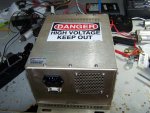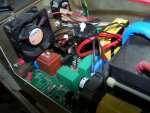It looks exactly like a 9 pin serial port. The power is a standard 120v 3 pin plug for the same cable as a computer uses. Ive looked for info on it for days now. I'd hate to fry it by randomly trying to jumper it like an argon... but I may have to try that if no other info surfaces. 

Welcome to Laser Pointer Forums - discuss green laser pointers, blue laser pointers, and all types of lasers
How to Register on LPF | LPF Donations
Navigation
Install the app
How to install the app on iOS
Follow along with the video below to see how to install our site as a web app on your home screen.
Note: This feature may not be available in some browsers.
More options

You are using an out of date browser. It may not display this or other websites correctly.
You should upgrade or use an alternative browser.
You should upgrade or use an alternative browser.
new co2 from old medical eq, water cld or not?
- Thread starter disma
- Start date


- Joined
- Sep 12, 2007
- Messages
- 9,399
- Points
- 113
So far it sounds identical to my PS. Do you have any pics?
GooeyGus
0
- Joined
- Mar 8, 2008
- Messages
- 2,669
- Points
- 48
disma said:It looks exactly like a 9 pin serial port. The power is a standard 120v 3 pin pkug for the same cable as a computer uses. Ive looked for info on it for days now. I'd hate to fry it by randomly trying to jumper it like an argon... but I may have to try that if no other info surfaces.
a 9-pin serial will just be logic level stuff... I think it would be pretty hard to screw something up via those ports (but I've also seen some really stupid use of logic pins... stuff that WILL mess up the PSU *cough* laser physics *cough*)
diachi
0
- Joined
- Feb 22, 2008
- Messages
- 9,700
- Points
- 113
Apparently the huge DANGER : High Voltage KEEP OUT signs don't deter you :
Why should they, ;D actually they entice me! I have built tesla coils with pole transformers that spark 8 foot or more, why would this little thing scare me, plus I wanted to identify the board in it. If it says "High Voltage, keep out" its gotta have good stuff in it! ;D It has some quite large flybacks in it. otherwise, I still dont know what the 9 pin plugs connections are.
- Joined
- Sep 22, 2007
- Messages
- 977
- Points
- 0
The 9-pin is probably the TTL control, the trigger/safe logic, etc.
- Joined
- Sep 12, 2007
- Messages
- 9,399
- Points
- 113
Nevermind. It was just the two connectors that are the same as mine. My 9-pin has TTL, On/off, intensity, interlock, and water safety shutoff (essentially another interlock). I'd give you the pinout, but yours looks nothing like mine, so you'd probably just blow it up 
My question is which pins are for what? If its just ttl then I may play around with it, but it may also have meter outputs, and it may have a power control input as well, in wich case couldn't I damage something by trying to short different pins on it?
:-?
:-?
- Joined
- Sep 22, 2007
- Messages
- 977
- Points
- 0
Well fire up the power supply and start taking voltage readings on the pins. Figure out levels and grounds. You could use an O-scope to see if there are any kinds of signals. When that's done begin tracing wires and see where they terminate. Figure out what the electronics are doing at that part of the board using your meters and scopes. It's old fashioned reverse engineering and something you will have to do if you really need to know the pinout and if some kind of jumpering is required just to operate the tube.





